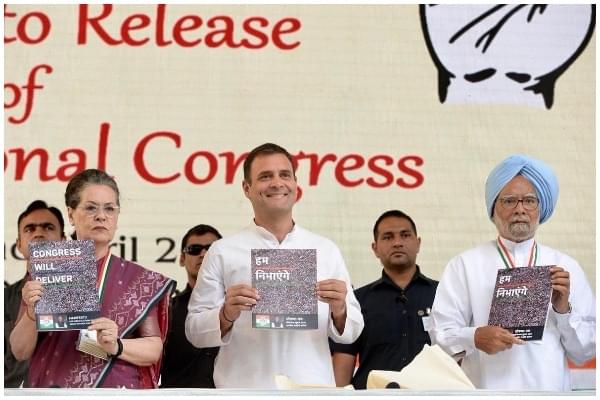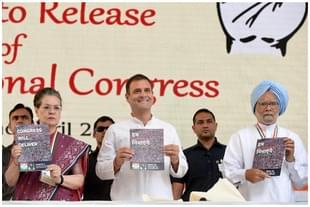Politics
A Tale Of Two Manifestos: An Agenda Of Clarity Versus A Programme Of Confusion
Geeta Bhatt
Apr 16, 2019, 02:08 PM | Updated 02:08 PM IST
Save & read from anywhere!
Bookmark stories for easy access on any device or the Swarajya app.


Democracy is all about choices that the people of a nation exercise to facilitate their governance. Every Indian would prefer to choose those who are committed to the nation and its people – both the marginalised as well as the capable. The manifestos of the Congress party and the Bharatiya Janata Party have recently been released, showcasing their vision for the next five years and the measures they propose to take to meet the aspirations of the people.
These documents are basically narrative positioning systems, intended to tell the voter where they stand on various issues. When the Congress says ‘it will deliver’, the future tense adopted is a tacit acceptance of the mistrust people have in its promises, while ‘Sankalpit Bharat Sashakt Bharat’ radiates a positive sense of determination and optimism.
The message by Rahul Gandhi in the Congress manifesto begins on a pessimistic note, as if Article 19, which bestows upon the citizens the ‘Freedom of Expression’, has ceased to exist. His declaration that the last five years have been “disastrous" for the people and that this is a time of “deep crisis” is way too alarmist, especially when increased infrastructure development, lower fiscal deficit, increased forex reserves and other statistics speak otherwise.
On the contrary, Prime Minister Narendra Modi presents his views on an optimistic note, listing the achievements of his government, admitting the challenges ahead, presenting a clear objective for 2022 and asking the citizens to participate in laying the foundation of an India they wish to shape by 2047, the year we shall celebrate 100 years of Independence.
The Congress manifesto, released for the upcoming 2019 Lok Sabha elections, was drafted under the chairmanship of P Chidambaram, who, along with his son Karti, is facing Enforcement Directorate proceedings for reportedly receiving bribes in the INX Media case. They are currently out on anticipatory bail. It may be recalled that Chidambaram’s wife, Nalini, is also facing a probe in the Sharada Chit fund scam.
With the present and the previous Congress party presidents already facing charges in the Rs 5,000-crore National Herald case, it is no wonder that poll promises on anti-corruption laws find reference in the manifesto under the ‘Good Governance’ head that also talks about the Rafale deal.
The BJP manifesto, prepared under the chairmanship of Home Minister Rajnath Singh, is emphatic on a corruption-free Bharat that finds mention in the prologue by the Prime Minister, the party president Amit Shah and Home Minister Rajnath Singh.
The Congress manifesto, on the other hand, while trivialising national security and sovereignty, focuses on a precipitously prepared facade of poverty and the deliverance of 'good governance'.
The manifesto also proposes to remove Section 124A of the Indian Penal Code, commonly known as the sedition law, as they claim it has been "misused" in the last five years. That the sedition law was exercised on many an occasion by the Congress party (by virtue of being in office for more than five decades), seems to have been forgotten.
Post-Independence, the sedition law was invoked in 1950 on the publisher and editor of the nationalist English magazine Organiser for publishing news, opinions, cartoons and photographs on Pakistan. This was perceived by the then Indian government as a 'threat’ to public safety.
One of the most quoted cases of sedition has been that of Kedarnath versus the State of Bihar in 1962. Kedarnath was convicted under Section 124A for accusing the Congress party of corruption, black marketing and tyranny, in his speech. Once again, the law was invoked in the interest of 'public order' although the attack was on a political party.
In the twenty-first century however, the Congress has used Section 124A selectively. In 2010, when Arundhati Roy, in the presence of Hurriyat hardliner, Syed Ali Shah Geelani, hurled accusations against the state on issues such as Kashmir, the Northeast, Telangana, as well as the Army, the UPA-II government chose not to slap sedition charges against her.
Post 2014, many abuses have been hurled at the present Prime Minister Narendra Modi, including the infamous "Will-cut-Modi-to-pieces" by Imran Masood of the Congress party. Ahmad Rana of the National Conference recently called the Prime Minister a "terrorist".
In spite of these provocations, the sedition law was exercised by the NDA government only when the sovereignty of the nation was challenged in speech, action, writing or conspiracy. In 2016, when slogans on ‘Azadi’ of Kashmir were raised in Jawaharlal Nehru University, to mark the death anniversary of Parliament attack mastermind Afzal Guru, Rahul Gandhi publicly extended support to the ‘Bharat Tere Tukde Honge’ gang. He was resolute in his support to the students, who were chanting anti-India and pro-Pakistan slogans. The sedition cases against the JNU students is yet to see the light of day.
The proposed amendment to the Armed Forces Special Powers Act (AFSPA) by the Congress to "balance" the rights of the Indian security forces and that of the citizens, is totally silent on the rights of soldiers while on duty. The intention to repeal laws providing immunity to the security forces on duty is a statement in itself on the moral quotient of the Congress.
Legitimising exceptions in conduct by the armed forces in the Congress manifesto speaks volumes on the lack of confidence the Congress has in India’s defence forces. The Prevention of Terrorism Act (POTA), 2002, was introduced by NDA-I during Atal Bihari Vajpayee’s regime to curb terror funding and outfits. The removal of POTA was one of the first major policy decisions by the Manmohan Singh-led UPA government after it was sworn in to govern in 2004. One can recall the various terror attacks which took place at Varanasi, Nagpur, Gorakhpur, Indian Institute of Science, Bangalore, and various other attacks in Mumbai, Delhi and Hyderabad during the UPA regime.
The BJP manifesto emphasises on ‘zero tolerance’ against terrorism and extremism and promises a free hand to the security forces in their efforts to protect the nation. It also addresses the issue of strengthening the armed forces, welfare of soldiers and modernisation of the police force.
On Jammu and Kashmir too, both the manifestos are in stark contrast. Defending Article 370 in its vision document makes the Congress appear hand-in-glove with its alliance partner,the National Conference, which has threatened to embark on a separatist agenda if Articles 370 or 35A are repealed.
Considering that senior leaders like Saifuddin Soz spoke on going “separate” from India if Article 35A was removed, and Ghulam Nabi Azad calling the Jammu and Kashmir police “murderers” reinforces the belief that the Congress is singing an anti-India tune. The BJP has, however, stood strong in its resolve to abrogate Article 370 and annul Article 35A of the Constitution.
It is important to note that a political party that has always made tall claims about its secular credentials and has accused BJP of playing the “communal” card, has documented its partisan stand wherein it wants the rest of the nation to be “secular” but Jammu and Kashmir to retain its “ethos”.
The Nyuntam Nyay Yojana (NYAY) is being projected by the Congress as the talking point of its manifesto. It proposes to give Rs 72,000 per annum to the poorest 20 per cent of the population. There is, however, no clarity on who constitutes the poor in this slab. Also, Sam Pitroda and other senior Congress leaders have hinted that taxes will be raised to fund this grandiose dole. The document talks of a separate agricultural budget, which is welcome, but their 2004 and 2009 manifestos also talked of a direct income support scheme for farmers that never materialised.
The Economic Survey 2016-17 of the Government of India had a chapter on Universal Basic Income (UBI), which proposed that social welfare schemes that constitute 5.2 per cent of the GDP, could be brought down to 2-3 per cent by taking the UBI forward. It is interesting to note that for the first time, a proposed scheme by the Congress party has an acronym like NYAY, which sounds like Hindi.
Coming to tax reforms, the Congress manifesto proposes to encourage the starting of new businesses by completely withdrawing Angel Tax. The party fails to mention that it was their government which had introduced this tax in 2013 on startups that received equity infusion in excess of their valuation.
The present government has already increased the exemption limit on Angel Tax from Rs 10 crore to Rs 25 crore and has also permitted startups to participate in government tenders, thus exempting them from the precondition of having previous experience.
The Congress manifesto speaks at length on the “ills” plaguing the MSME sector and steps to “improve” upon them, not withstanding that the present government already has a 59-minute single window for business loans from Rs 10 lakh up to Rs 1 crore without any collateral.
The BJP has provided a roadmap so that the country becomes the third largest economy in the world, with investments of Rs 100 lakh crore in infrastructure. Both manifestos talk about promoting art and culture, but the Congress is silent on promoting cultural heritage, Indian linguistic culture, Ram Mandir and Sabarimala.
The BJP manifesto is vociferous in micro detailing its five-year agenda, covering culture to foreign policy, while the Congress has placed its policies under a broad spectrum. For example, the BJP commits itself to seeking permanent membership of the United Nations Security Council, while the Congress is fine with just “persuading” the United Nations to “review” the list of terrorists and expanding terror sanctions.
The promises of doles and governance in the Congress manifesto have been subsumed by the proposed dilution of laws which compromise our national security and sovereignty, expose us to threats of terror, infiltration and Naxalism.
The BJP manifesto has attempted to capture the ambitions and aspirations of a young nation with clear developmental goals, taking along ideological concerns that are beyond electoral politics.





